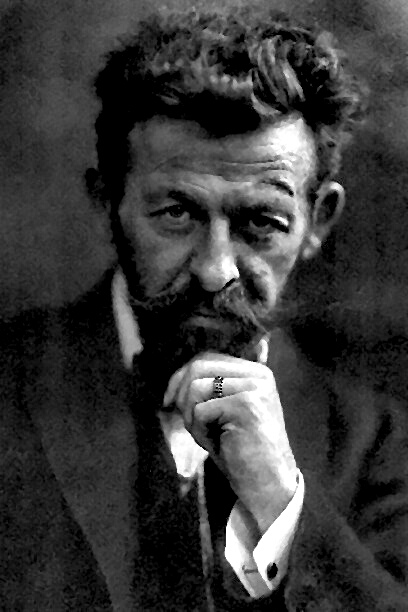Transfiguration isn't a word you come across very often. Well, of course Transfiguration became a whole discipline in the world of Harry Potter. And although I must confess that I have imagined foregoing laboratory experiments for a Transfiguration class with Professor McGonagall, I'll be going in a slightly different direction today.
 Richard Dehmel From Hamburgische Männer und Frauen am Anfang des XX. Jahrhunderts, Hamburg 1905 (see also Image, Zeno.org, ID number 20001864742)
Richard Dehmel From Hamburgische Männer und Frauen am Anfang des XX. Jahrhunderts, Hamburg 1905 (see also Image, Zeno.org, ID number 20001864742)
 Portrait of Arnold Schoenberg Gerstl, Richard - Arnold Schoenberg Seated (1906).jpg derivative work: Tim riley
Portrait of Arnold Schoenberg Gerstl, Richard - Arnold Schoenberg Seated (1906).jpg derivative work: Tim riley
Instead, I'm thinking about the more general concept of transfiguration and the poem and string sextet both by the name Verklärte Nacht - Transfiguration Night. You can find the basic background on Wikipedia - Verklärte Nacht is one of Arnold Schoenberg's early works, and combines Romanticism with something new. He wrote it in just three weeks in 1899 using Richard Dehmel's poem (1896) and his romantic feelings for his future wife as inspiration.
 Richard Dehmel From Hamburgische Männer und Frauen am Anfang des XX. Jahrhunderts, Hamburg 1905 (see also Image, Zeno.org, ID number 20001864742)
Richard Dehmel From Hamburgische Männer und Frauen am Anfang des XX. Jahrhunderts, Hamburg 1905 (see also Image, Zeno.org, ID number 20001864742)The poem and the music, which premiered in 1902, were quite controversial at the time - partly because it had the audacity to discuss premarital sex without criticizing it! Indeed Dehmel ran in to quite a bit of trouble for some of his poetry - quite scandalous. In addition, Schoenberg started breaking some musical rules that had everyone up in arms. Now of course, neither the subject matter nor the music brings such ire. You can listen to the music from one of several recordings free on YouTube - either as a sextet for two violins, two violas and two cellos as originally written, or arranged for a chamber orchestra. Maybe classical music isn't really your thing, but try out just a little bit - remember, you're listening to a rule breaker! Sometimes the music is quite open and bare. He sometimes has swirling nests of notes that seem all jumbled up, but somehow in a beautiful way. The world can just shrink away while you listen.
 Portrait of Arnold Schoenberg Gerstl, Richard - Arnold Schoenberg Seated (1906).jpg derivative work: Tim riley
Portrait of Arnold Schoenberg Gerstl, Richard - Arnold Schoenberg Seated (1906).jpg derivative work: Tim rileyWhen I first heard this piece side by side with the poem I was in high school. I was struck by how the music and the words together worked to make a greater depth of experience. To this day, I still like to look at the words and listen to the music from time to time and think about where the various parts of the poem might fit. Try it - see if you can decide where the different sections of the poem match the music. You can hear the fear and turmoil as the woman reveals that she is carrying another man's child, that she became pregnant before they met. Then the man takes a while to think and finally brings love and acceptance - even declaring that the unborn child will be transfigured into his child. And frankly, I find it remarkable that a poem written more than 100 years ago conveys a sentiment that some might still have trouble accepting today.
Of course, the music can also be appreciated apart from the poem. The raw emotion of the music, turmoil followed by resolution to me brings hope for times of difficulty. If the beginning of the song is times of pandemic, the end is our future when we have effective measures for prevention and treatment and we can move forward. If the beginning is political division that separates us from friends or relatives, the end is reconciliation. There is always hope for times of trial to be transfigured into something new and better.
For both the Dehmel's poem and Schoenberg's piece, one of the messages I have always taken is that there is always the possibility that when someone raises the secret that they were afraid of, that they thought could only bring rejection and hurt - they may just find that none of it matters and it will be transfigured by love.
